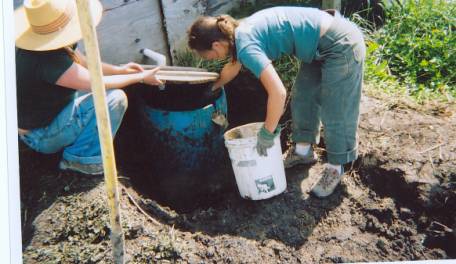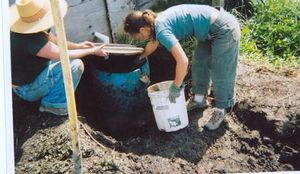(changed great to greater) |
|||
| Line 162: | Line 162: | ||
#Save a file on your computer and remember where, i.e. what folder. | #Save a file on your computer and remember where, i.e. what folder. | ||
#*Make sure to give it a unique name, such as your projectname_description.jpg | #*Make sure to give it a unique name, such as your projectname_description.jpg | ||
#*For photos: Save the photo with no dimension | #*For photos: Save the photo with no dimension greater than 800 pixels, and do less if big is not necessary | ||
#*For photos: Save the photo rotated in the proper orientation | #*For photos: Save the photo rotated in the proper orientation | ||
#In Appropedia Click "Upload file" | #In Appropedia Click "Upload file" | ||
Revision as of 23:55, 25 October 2006
You can also see the full list of help topics.
If you have a technical question which is not answered here, you may wish to check the help pages on Wikipedia (as Appropedia and Wikipedia use the same software); or please ask at the Technical questions page - we'll be glad to help!
Creating a new page
One way to start a new page is to perform a search for the new title with the Go button. When the search finds nothing, press "create the article".
Naming conventions
The name is case-sensitive, except for the first letter, which is automatically made upper-case. Don't capitalize all words, except for common names, e.g. we use Appropriate technology, not Appropriate Technology
Formatting
You can format your text using wiki markup. This consists of normal characters like asterisks, single quotes or equation marks which have a special function in the wiki, sometimes depending on their position. For example, to format a word in italic, you include it in two single quotes like ''this''
Paragraphs
Appropedia ignores normal line breaks. To start a new paragraph, leave an empty line. You can also start a newline with the HTML tag <br>.
Formatting Marks
| Template:Hl3 align="center"|Description | Template:Hl3 align="center"|You type | Template:Hl3 align="center"|You get |
| applies anywhere | ||
| Italify text | ''italic'' | italic |
| Bold text | '''bold''' | bold |
| Bold and italic | '''''bold & italic''''' | bold & italic |
| Escape wiki markup | <nowiki>no ''markup''</nowiki> | no ''markup'' |
| only at the beginning of the line | ||
| Headings of different sizes |
==level 1== |
Level 1Level 2Level 3Level 4 |
| Horizontal rule (use sparingly) |
---- |
|
| Bullet list |
* one |
|
| Numbered list |
# one |
|
| Definition list |
;Definition |
|
| Preformatted text |
a space at the |
a space at the begin of the line creates preformatted text |
Links
| Template:Hl3 align="center"|Description | Template:Hl3 align="center"|You type | Template:Hl3 align="center"|You get |
| Internal link | [[Page]] | Page |
| Piped link | [[Page|different text]] | different text |
| External link | http://mediawiki.org | http://mediawiki.org |
| External link, different title |
[http://mediawiki.org MediaWiki] | MediaWiki |
| External link, unnamed |
[http://mediawiki.org] | [1] |
Here are some variations of two important types of links in Appropedia: internal links to other pages in the wiki - including files (such as pictures) and external links to other websites.
To add an internal link, enclose the name of the page you want to link to in double square brackets. When you save the page, you'll see the new link pointing to your page. If the page exists already, it is displayed in blue, empty pages are displayed in red.
The first letter of the target page is automatically capitalized and spaces are represented as underscores (typing an underscore in the link has the same effect as typing a space, but is not recommended).
External links are in the form link name (resulting in link name), with the link name separated from the URL by a space. Links without link names will be numbered: [2] becomes [1]. Links with no square brackets will be displayed in their entirety: http://www.example.org .
HTML
Some HTML-Tags are allowed in Appropedia, for example <code>, <div>, <span> and <font>.
Files
Appropedia strongly encourages the use of supporting media as a pedagogical tool. Media that supports multilingual learning is also encouraged. Following are some instructions and guidelines on including media in your page.
Uploading
Before uploading, please ensure that you have rights to upload and redistribute the file(s) in question and that you in turn grant these rights to others.
- Save a file on your computer and remember where, i.e. what folder.
- Make sure to give it a unique name, such as your projectname_description.jpg
- For photos: Save the photo with no dimension greater than 800 pixels, and do less if big is not necessary
- For photos: Save the photo rotated in the proper orientation
- In Appropedia Click "Upload file"
- This link is located in the menu on the left in the "toolbox"
- Click "Browse..."
- This button is located in the Upload file page you now have up
- This will bring up your operating system's standard file open dialog
- Browse your computer for you file
- Choose the file
- This will fill the Source and Destination Name of that file into the corresponding text fields.
- Enter a summary (this step is optional but considerate)
- Then press the "Upload file" button to finish the upload. This may take some time if you have a slow internet connection.
The preferred formats are JPEG for photographic images, PNG for drawings and other iconic images, and OGG for sounds. Please name your files descriptively to avoid confusion.
Please note that as with wiki pages, others may edit your uploads (and admins may delete them) if they think it serves the project, and you may be blocked from uploading if you abuse the system.
Once your file is uploaded you will probably want to put it in your page.
Avoid huge image files
Huge image files should be avoided - it puts a load on the servers and makes pages load slowly (especially in remote or underdeveloped areas). Usually the file should be compressed to 100 kB or less (200 kB or less for a very large or detailed picture). Raw photos from digital cameras can be more than 1 MB, which is much too large.
An image editing tool can help you make it smaller. An excellent free program for Windows users is Easy Thumbnails. By default it makes small "thumbnail" images, but the output can be adjusted to any size, and a preview is given (with the output file's size in the top bar). This program seems to give optimal quality for a relatively small image size.
Linking
To put your picture (file) in your page, you link to it by placing double brackets around the name of the file page (as if it was another Appropedia page). For instance if you just uploaded a file named AEFprevfilt2.jpg, you would but double brackets around image:AEFprevfilt2.jpg.
| Template:Hl3 align="center"|Description | Template:Hl3 align="center"|You type | Template:Hl3 align="center"|You get |
| Just the picture | [[Image:AEFprevfilt2.jpg]] | 
|
| Thumbnailed | [[Image:AEFprevfilt2.jpg|thumb]] |  |
| Thumbnailed with caption | [[Image:AEFprevfilt2.jpg|thumb|Fig 1: Cleaning out the old filter]] |  |
| Thumbnailed with caption and location |
[[Image:AEFprevfilt2.jpg|thumb|left|Fig 1: Cleaning out the old filter]] |  |
| Gallery | <gallery> Image:AEFprevfilt2.jpg|Fig 1: Cleaning out the old filter Image:AEFprevfilt2.jpg|Fig 1a: This would be cooler as a different photo Image:AEFprevfilt2.jpg|Fig 1b: This would be cooler as a different different photo </gallery> |
|
See Wikipedia:Wikipedia:Picture_tutorial for more options.
Editing Pages
See Wikipedia:How to edit a page and Wikipedia:Help:Contents/Editing Wikipedia
External links
